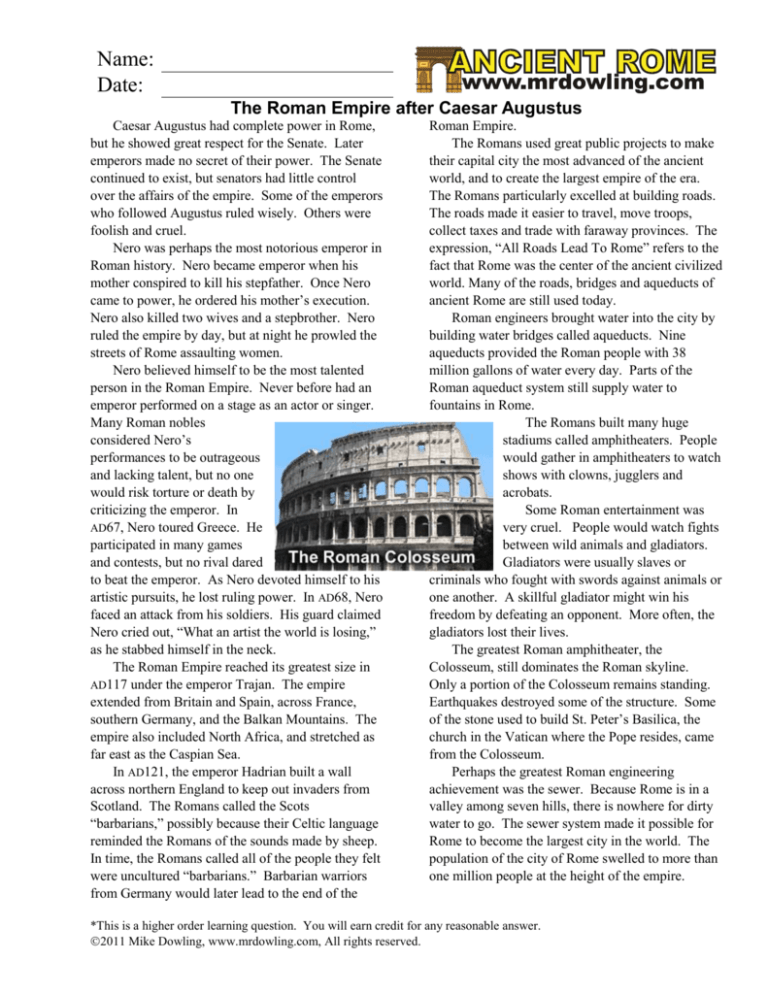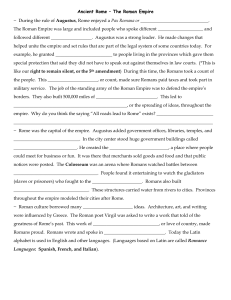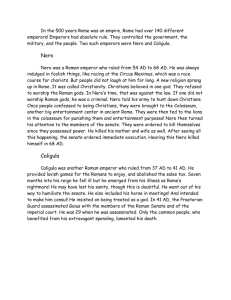
Name:
Date:
The Roman Empire after Caesar Augustus
Caesar Augustus had complete power in Rome,
but he showed great respect for the Senate. Later
emperors made no secret of their power. The Senate
continued to exist, but senators had little control
over the affairs of the empire. Some of the emperors
who followed Augustus ruled wisely. Others were
foolish and cruel.
Nero was perhaps the most notorious emperor in
Roman history. Nero became emperor when his
mother conspired to kill his stepfather. Once Nero
came to power, he ordered his mother’s execution.
Nero also killed two wives and a stepbrother. Nero
ruled the empire by day, but at night he prowled the
streets of Rome assaulting women.
Nero believed himself to be the most talented
person in the Roman Empire. Never before had an
emperor performed on a stage as an actor or singer.
Many Roman nobles
considered Nero’s
performances to be outrageous
and lacking talent, but no one
would risk torture or death by
criticizing the emperor. In
AD67, Nero toured Greece. He
participated in many games
and contests, but no rival dared
to beat the emperor. As Nero devoted himself to his
artistic pursuits, he lost ruling power. In AD68, Nero
faced an attack from his soldiers. His guard claimed
Nero cried out, “What an artist the world is losing,”
as he stabbed himself in the neck.
The Roman Empire reached its greatest size in
AD117 under the emperor Trajan. The empire
extended from Britain and Spain, across France,
southern Germany, and the Balkan Mountains. The
empire also included North Africa, and stretched as
far east as the Caspian Sea.
In AD121, the emperor Hadrian built a wall
across northern England to keep out invaders from
Scotland. The Romans called the Scots
“barbarians,” possibly because their Celtic language
reminded the Romans of the sounds made by sheep.
In time, the Romans called all of the people they felt
were uncultured “barbarians.” Barbarian warriors
from Germany would later lead to the end of the
Roman Empire.
The Romans used great public projects to make
their capital city the most advanced of the ancient
world, and to create the largest empire of the era.
The Romans particularly excelled at building roads.
The roads made it easier to travel, move troops,
collect taxes and trade with faraway provinces. The
expression, “All Roads Lead To Rome” refers to the
fact that Rome was the center of the ancient civilized
world. Many of the roads, bridges and aqueducts of
ancient Rome are still used today.
Roman engineers brought water into the city by
building water bridges called aqueducts. Nine
aqueducts provided the Roman people with 38
million gallons of water every day. Parts of the
Roman aqueduct system still supply water to
fountains in Rome.
The Romans built many huge
stadiums called amphitheaters. People
would gather in amphitheaters to watch
shows with clowns, jugglers and
acrobats.
Some Roman entertainment was
very cruel. People would watch fights
between wild animals and gladiators.
Gladiators were usually slaves or
criminals who fought with swords against animals or
one another. A skillful gladiator might win his
freedom by defeating an opponent. More often, the
gladiators lost their lives.
The greatest Roman amphitheater, the
Colosseum, still dominates the Roman skyline.
Only a portion of the Colosseum remains standing.
Earthquakes destroyed some of the structure. Some
of the stone used to build St. Peter’s Basilica, the
church in the Vatican where the Pope resides, came
from the Colosseum.
Perhaps the greatest Roman engineering
achievement was the sewer. Because Rome is in a
valley among seven hills, there is nowhere for dirty
water to go. The sewer system made it possible for
Rome to become the largest city in the world. The
population of the city of Rome swelled to more than
one million people at the height of the empire.
*This is a higher order learning question. You will earn credit for any reasonable answer.
2011 Mike Dowling, www.mrdowling.com, All rights reserved.
Name:
Date:
Answer in complete sentences
1. List four examples of Roman technology.
*2. How do you think Rome’s many roads eventually helped lead to the downfall of the city?
*3. Roman leaders encouraged some of the more bloodthirsty elements of Roman entertainment. Do you think
this type of entertainment is good or bad for a society? Explain your answer.
*4. What problems would have occurred in Rome if the city that large did not have an adequate sewage system?
*5. Explain why only a portion of the Roman Colosseum remains standing.
*6. Do you think that managing the Roman Empire in AD117 was easy or difficult? Defend your answer.
*7. Xenophobia is the fear or contempt of foreign people and cultures? Describe an example of Roman
xenophobia.
*This is a higher order learning question. You will earn credit for any reasonable answer.











